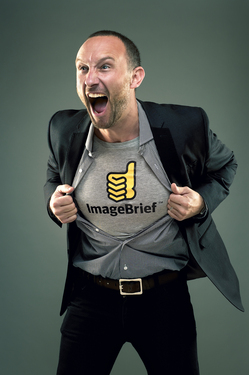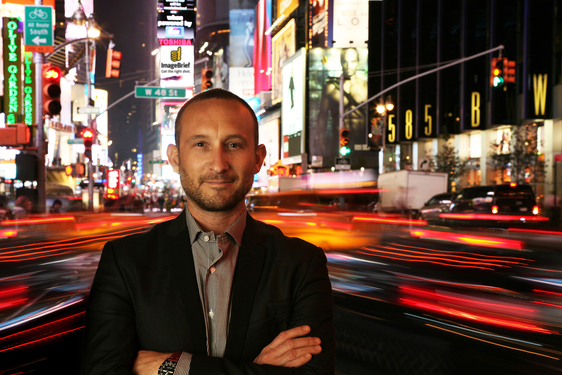Imagine if you had a project that required a certain, even specific, image and rather than pool through thousands of images in a stock library, you could personally describe the photo you have in mind in great detail to a pool of professional photographers. And, imagine if these photographers would then present, for your consideration, their professional images that match your description. You don't have to imagine anymore. This is how photo licensing is done in this new age of the arts. This is how licensing is done through ImageBrief.
Photo Credit: Michael Kraus
This new licensing concept is the brainchild of Simon Moss, co-founder of ImageBrief. I was intrigued by the business model, both as a photographer and a book cover designer who often needs specific images for my own projects. As such, Simon was kind enough to answer my questions in this one-on-one interview.
HH: What did you do before launching ImageBrief?
SM: I ran a stock library with Meg, co-founder of ImageBrief - and more importantly my wife. It was a traditional photography site.
HH: What was your motivation for launching a crowdsourcing platform for photographers to sell images?
SM: The way buyers used our original stock photography platform gave us great insight. Although we'd invested heavily in the search capability of our original business, we still received emails from buyers requesting very specific images that we couldn't easily provide.
But we knew the content was out there, sitting on the hard drives of photographers around the world. We'd share requests with photographers we thought might have the shot. They would respond with images that matched the brief perfectly and were able to monetize work that hadn't yet been made available online.
We knew connecting buyers and sellers in this way would change the industry for the better. That was when ImageBrief was born.

Photo Credit: Michael Kraus
HH: What are the biggest trends that have changed the photography business in the past decade?
SM: So much has changed, but the place it starts is simply the tools available. Photography became a business that was "end-to-end digital" - from the moment a shot was taken to its final use. Like all media businesses, new tools suddenly emerged that made the production of content - in this case a photograph - easier than ever.
Cheap digital SLRs flooded the market and, good or bad, there was an explosion in the volume of photography from amateurs suddenly competing with professionals. I really think you can trace everything back to that.
With this came millions of images from people willing to charge much less per shot. This facilitated an explosion in lower-cost stock libraries like Shutterstock, while the higher-end of the market retreated to Getty. Not the most effective solutions for marketers or photographers.
We created an infographic that explains this in greater detail.

ImageBrief sourced, licensed, and obtained model releases for this candid image used on Facebook's own page to promote their new Nearby Friends feature.
Photo credit: Jazzmine Beaulieu
HH: With the increased popularity of Instagram, Flickr and others, user generated images are everywhere. How can photographers survive when competition for sales has skyrocketed?
SM: You're right about the competition sky-rocketing, but that has less to do with platforms like Instagram than with the means of production so widely available.
The majority of amateur user-generated content is not sufficient for commercial purposes. Resolution, image sizes and similar quality factors are an issue. But beyond that, brands, publishers and agencies still require model-released content they're confident won't show up in a competitor's marketing. ImageBrief alone connects buyers directly to photographers who can fulfill these needs. It will always be hard for most artists to earn a living from their craft, but we're giving photographers better opportunities to succeed.
HH: What is the coolest use of an image sold via ImageBrief?
SM: We've facilitated so many wonderful images it's impossible to pick one. It's like choosing a favorite child! What gets us really excited is where our photographers' work is seen, including a national social campaign for Land Rover, the cover of Travel + Leisure, on Facebook's own page, and images featured in the rebranding of a global pharmaceutical company. It's very rewarding.

Photo Credit Ian Maclellan

Photo Credit Ian Maclellan

Photo Credit: Chip Kalback

Photo Credit: Chip Kalback
HH: Do you dabble in photography? If so, have you ever sold any images?
SM: My background is in technology. Coupled with Meg's experience as a photo editor and licensing specialist, we are the perfect team to provide a platform where photographers can build their business. We leave the actual photography to our fast growing network of 20,000+ phenomenal photographers!
HH: How many images has ImageBrief sold for photographers since it launched?
SM: Since our official launch last year in New York we've sold thousands of images. However, the impact we're having on the professional photography community extends beyond sheer volume. Images on ImageBrief sell for anywhere from $250 to $30,000, and we pay our photographers up to 70% of every sale, more than double the standard industry commission. In addition, we recently began enabling buyers to hire photographers directly through ImageBrief. When a photographer books a job through ImageBrief, they keep 100% of the fee. So, these combined opportunities make for a very happy photographer community.

Chef Uri of Uri Buri Restaurant in Acre, Tel Aviv. This specific request sourced through ImageBrief for a magazine editorial.
Photo Credit: Yadid Levy
HH: How do you see photography changing over the next decade?
SM: We see photography becoming more competitive, more social and more mobile. Possibly the biggest change will come from mobile phone cameras taking SLR-quality images. Once that happens it levels the playing field even further, and it comes down to the talents of the person taking the shot. There will always be a market for the photographer who has an "eye" for seeing what no one else can.
HH: Since everyone loves to "right click and save" images online - how can photographers protect themselves?
SM: At ImageBrief we take all the standard precautions such as watermarking the shots on our site, not being able to right-click and save a shot, all these kinds of things.
We are also looking at implementing technology that allows us to track images that are used without permission. This generally doesn't happen with the work we sell, but we acknowledge that on occasion work will be stolen. Therefore, we are putting measures in place to identify who is responsible and ensure our photographers are appropriately compensated.
At the end of the day, photographers should only do business on platforms and with people they trust. We're working hard every day to achieve this so that we're the platform of choice for the world's most talented photographers.
***
Thank you, Simon!
